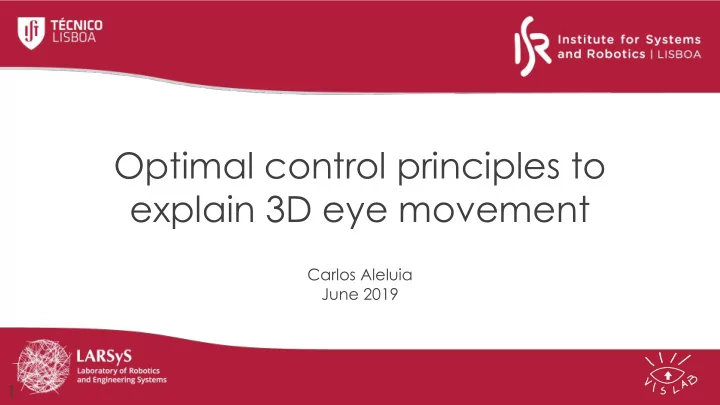

Optimal control principles to explain 3D eye movement Carlos Aleluia June 2019 1 Computer and Robot Vision Lab
Outline 1. Problem, Motivation and Approach 2. Models and Methods 3. Implementation 4. Experiments and Results 5. Conclusions and Future Work Computer and Robot Vision Lab 2
Problem Human eye has 6 muscles (grouped in antagonistic pairs that generate 3 DOF) However, only 2 DOF are needed to fixate on a plane Purpose of the mechanisms that deal with this issue still remain unknown Computer and Robot Vision Lab 3
Motivation Eye orientation abides certain rules (Listing’s Law) Understanding of these principles is crucial Computer and Robot Vision Lab 4
Approach Apply optimal control methods to a simulator that resembles the real robotic model, trying to obtain similar dynamic properties as the human eye Define set of cost functions and respective trade-offs under which the system behaves similarly to the human eye, which may include: i) Orientation accuracy ii) Time spent iii) Energy consumed iv) Motor effort Computer and Robot Vision Lab 5
Non-linear Model Input - motor rotation (in degrees) Output - eye orientation (represented by a rotation vector) insertion points on the motor plates Dependencies are non-linear due to rotations, string/elastic force deadzone... insertion points on the eye Computer and Robot Vision Lab 6
Linearization It’s possible to approximate the non-linear model by a linear system, using system identification methods In our case, identified model is a discrete time-invariant state space model: 2nd order system in each direction: 𝑚 =2 𝘯 Computer and Robot Vision Lab 7
Optimal Control saccade accuracy cost duration input sequence energy cost duration cost Computer and Robot Vision Lab 8
Optimal Control Energy Cost: Proportional to motor velocity: Computer and Robot Vision Lab 9
Optimal Control Duration Cost: Parameter 𝛾 has to be tuned Computer and Robot Vision Lab 10
Optimal Control Approach 1: Planned Trajectory Listing’s plane is implicitly defined: imposes a restriction on 𝑠 x for all time Computer and Robot Vision Lab 11
Optimal Control Approach 2: Fixed Final Orientation This approach imposes a restriction on 𝑠 x only for final time Computer and Robot Vision Lab 12
Optimal Control Approach 3: Free Torsion This approach does not impose any restriction on 𝑠 x Computer and Robot Vision Lab 13
Non-linear Model - Simulink The forces and corresponding torques are computed for each iteration Output is obtained by integrating the equations of motion Computer and Robot Vision Lab 14
Non-linear Model - Simulink Computer and Robot Vision Lab 15
Experiments 1) Study statistics on 𝑠 x using output for all possible saccades, starting from straight ahead 2) Study the same statistics on 𝑠 x but this time doing all saccades in sequence 3) Analyze the dependencies of saccade duration and peak velocity on saccade amplitude Computer and Robot Vision Lab 16
1- Saccades starting from origin Approach 𝞽 rx (°) Planned Trajectory 0.6195 Fixed Final Orientation 0.5217 Free Torsion 1.3659 𝑦𝑨 and 𝑧𝑨 planes for fixed final orientation approach Computer and Robot Vision Lab 17
2- Saccades done in sequence Approach 𝞽 rx (°) Planned Trajectory 1.4065 Fixed Final Orientation 1.4921 Free Torsion 2.8762 𝑦𝑨 and 𝑧𝑨 planes for fixed final orientation approach Computer and Robot Vision Lab 18
3- Dependencies on saccade amplitude Saccade duration is expected to increase with amplitude Peak velocity is expected to saturate Computer and Robot Vision Lab 19
Conclusions and Future Work Reasonably good results were achieved so far using the trade-off found Despite the nonlinearities, overall optimization works fine Next steps in this work: attempt to reduce 𝞽 rx ○ analyze feasibility of aggregation of different linear models ○ study effects of minimization of motor effort ○ test on real system (possibly even the new one being built?) ○ Computer and Robot Vision Lab 20
Thank you! Questions? 21 Computer and Robot Vision Lab
Recommend
More recommend